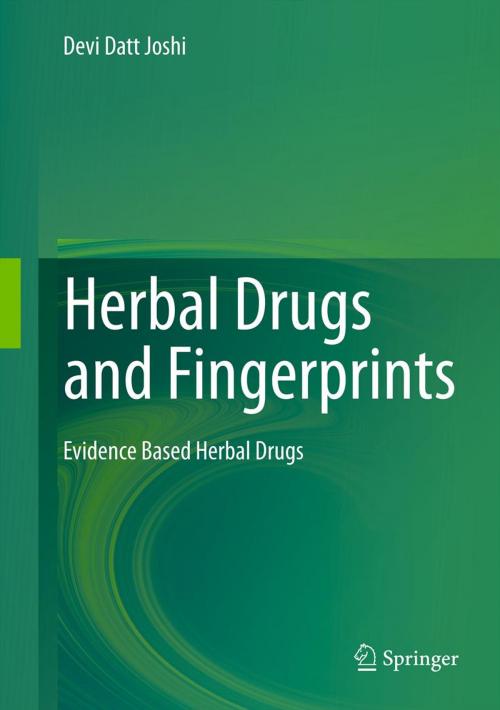Herbal Drugs and Fingerprints
Evidence Based Herbal Drugs
Nonfiction, Health & Well Being, Medical, Specialties, Pharmacy, Science & Nature, Science, Biological Sciences| Author: | Devi Datt Joshi | ISBN: | 9788132208044 |
| Publisher: | Springer India | Publication: | November 2, 2012 |
| Imprint: | Springer | Language: | English |
| Author: | Devi Datt Joshi |
| ISBN: | 9788132208044 |
| Publisher: | Springer India |
| Publication: | November 2, 2012 |
| Imprint: | Springer |
| Language: | English |
Evidence based herbal drugs are on hi-acceptance day by day due to health friendly nature compared to synthetic drugs. The active ingredients in herbal drugs are different chemical classes, e.g. alkaloids, coumarins, flavonoids, glycosides, phenols, steroids, terpenes etc., are identified at molecular level using current analytical practices, which are unique characteristic, as finger, so known as fingerprints. The fingerprints are used for assessment of quality consistency and stability by visible observation and comparison of the standardized fingerprint pattern, have scientific potential to decipher the claims made on these drugs for authenticity and reliability of chemical constituents, with total traceability, which starts from the proper identification, season and area of collection, storage, their processing, stability during processing, and rationalizing the combinational in case of polyherbal drugs. These quality oriented documents have ample scientific logics so well accepted globally by regulatory authorities and industries, to determine intentional/ unintentional contamination, adulteration, pollutants, stability, quality, etc. parameters. Based on geo-climatic factors, a same plant species has different pharmacological properties due to different ingredients; such regional and morphological variations are identified by fingerprints, at the time of collection of the medicinal herb. The chromatographic (TLC, HPTLC, HPLC, GC,) and spectral (UV-Vis., FTIR, MNR, MS, LC-MS, GC-MS etc.) techniques have world-wide strong scientific approval as validated methods to generate the fingerprints of different chemical classes of active ingredients of herbal drugs. Presently there is a need for a book having all the fingerprinting techniques for herbal drugs at a place with theory, case studies and art to discover patentable forms. The present book is a mile stone in the subject, to be utilized by Scientists, Medical Doctors, Technicians, Industrialists, Researchers, and Students both in PG and UG levels.
Evidence based herbal drugs are on hi-acceptance day by day due to health friendly nature compared to synthetic drugs. The active ingredients in herbal drugs are different chemical classes, e.g. alkaloids, coumarins, flavonoids, glycosides, phenols, steroids, terpenes etc., are identified at molecular level using current analytical practices, which are unique characteristic, as finger, so known as fingerprints. The fingerprints are used for assessment of quality consistency and stability by visible observation and comparison of the standardized fingerprint pattern, have scientific potential to decipher the claims made on these drugs for authenticity and reliability of chemical constituents, with total traceability, which starts from the proper identification, season and area of collection, storage, their processing, stability during processing, and rationalizing the combinational in case of polyherbal drugs. These quality oriented documents have ample scientific logics so well accepted globally by regulatory authorities and industries, to determine intentional/ unintentional contamination, adulteration, pollutants, stability, quality, etc. parameters. Based on geo-climatic factors, a same plant species has different pharmacological properties due to different ingredients; such regional and morphological variations are identified by fingerprints, at the time of collection of the medicinal herb. The chromatographic (TLC, HPTLC, HPLC, GC,) and spectral (UV-Vis., FTIR, MNR, MS, LC-MS, GC-MS etc.) techniques have world-wide strong scientific approval as validated methods to generate the fingerprints of different chemical classes of active ingredients of herbal drugs. Presently there is a need for a book having all the fingerprinting techniques for herbal drugs at a place with theory, case studies and art to discover patentable forms. The present book is a mile stone in the subject, to be utilized by Scientists, Medical Doctors, Technicians, Industrialists, Researchers, and Students both in PG and UG levels.















